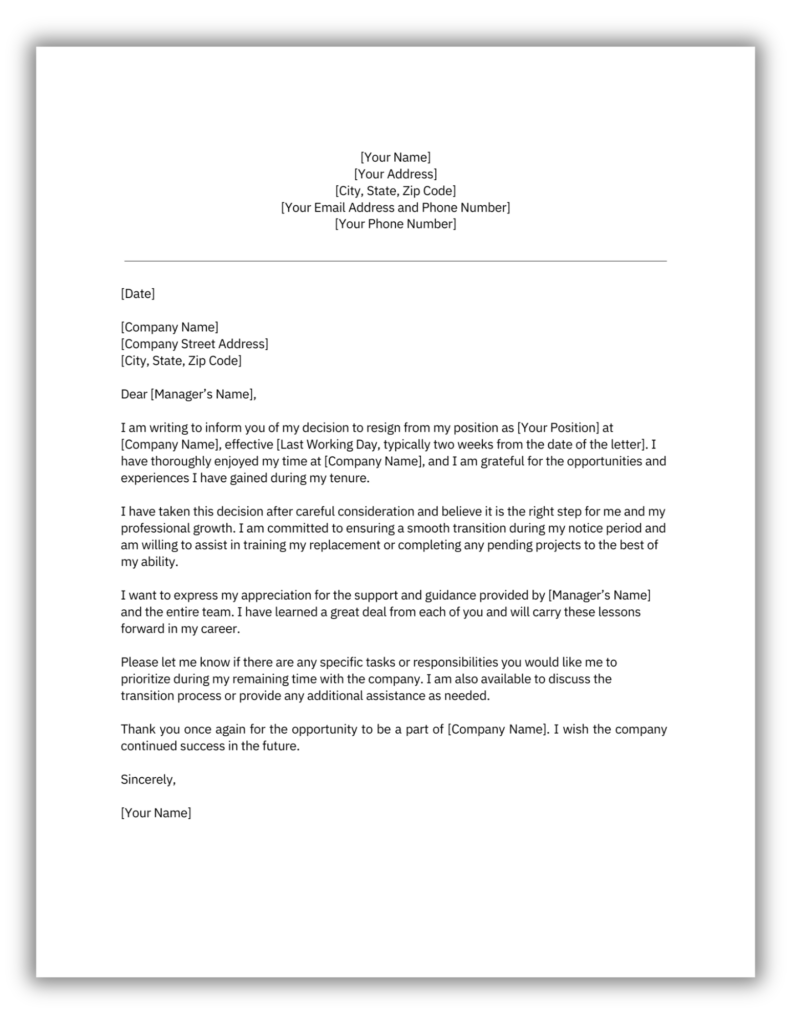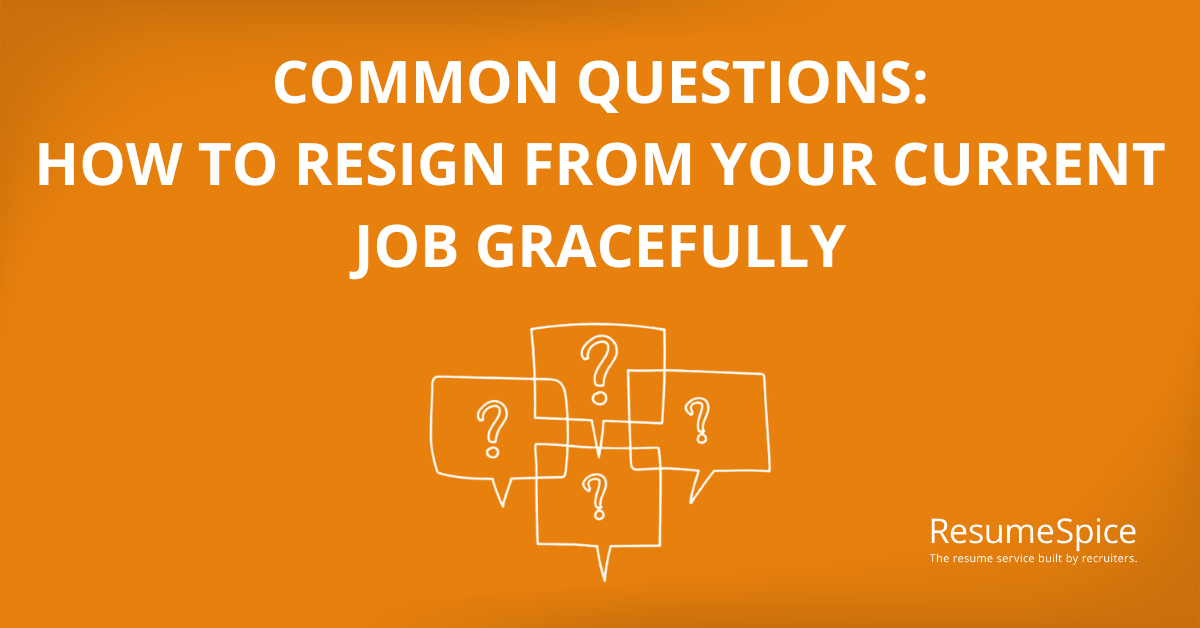How to Resign from Your Current Job Gracefully

As Seen In:




Ready to resign from your job? This blog is here to guide you through the pivotal steps to take for a smooth and professional departure. We are here to provide actionable advice on determining the right time to leave, drafting a clear resignation letter, and handling the final discussion with your employer, making sure you know how to resign from your current job with respect and foresight.
Key Takeaways
- Before resigning, it’s crucial to reflect on your reasoning, explore alternatives within the company, and assess job market opportunities for a smooth career transition.
- The timing of your resignation should consider personal circumstances, major company events, and industry trends to maintain professional relationships and future opportunities.
- Crafting a professional resignation letter requires a few essential components such as maintaining a positive tone, and staying clear of negative or unnecessary details.
Evaluating Your Decision to Resign
Taking the leap to resign from your job is not a decision to be taken lightly. It’s a pivotal step that can shape your future career. Whether it’s due to personal reasons, job dissatisfaction, or a new job offer, it’s essential to reflect on your motives for considering leaving your current job. Aligning your decision with your career objectives and personal ethics is critical before crafting that formal resignation letter.
Before you make the decision to resign, it’s advisable to explore other options within your company. Could a role change, or addressing specific concerns, lead to a more satisfactory outcome? Stepping back and evaluating these alternatives might save you from making a rash decision that you might regret later.
In addition to reflecting on your reasons for wanting to quit a job, understanding the market demand for your skills is vital. The feasibility of finding a new job in a timely manner should be considered before making a decision to resign. This ensures that you’re moving towards a future that holds promising opportunities.
Reflect on Your Reasons for Leaving
To make an informed decision, it’s imperative to reflect on your reasons for considering to resign from your job. Are you driven by personal dissatisfaction? Or are there external factors at play? By identifying and analyzing these factors, you can gain clarity on whether the issues are resolvable within your current workplace or if resignation is the best option. This understanding will also assist in explaining your decision to future employers and during job interviews.
Explore Alternative Solutions
Before you officially resign, it’s beneficial to explore alternative solutions. Discussing your concerns with your manager or HR could reveal unknown opportunities for professional development, or resolve issues that are prompting your desire to resign. Also, consider exploring new challenges within your current company or different roles that could address your dissatisfaction.
✨Tip: Requesting a performance review during your notice period can help align personal goals with transition objectives, creating a win-win situation for both you and your employer.
Evaluate Job Market and Opportunities
Researching the job market is also an essential task to better understand the current health of your industry and your own employability. This is especially true if you do not have a new job lined up before you quit your current one. So, take the time to assess the job market to ensure there are opportunities and a demand for your skills. This will impact the likelihood of a successful career transition post-resignation.
Making this decision a thoughtful one is meant to help avoid an extended period of unemployment after leaving your current job.
✨Tip: Exploring new opportunities? Check out our guide on how to stay organized during your job search.
Timing Your Resignation
Timing is everything, especially when it comes to resigning from your job. You don’t want to burn bridges or leave your team high and dry by quitting at an inopportune time. So, how do you figure out the best time to hand in your resignation? You’ll need to consider your personal situation, company projects, and broader industry trends to make an informed decision.
If you’re involved in a big project or event, it’s advisable to give two months’ notice to ensure a smooth transition. This not only allows your employer ample time to find a replacement but also demonstrates your consideration and professionalism. Additionally, being aware of industry trends can influence the timing of your resignation. For instance, if there’s a wave of layoffs in your industry, it might not be the best time to quit your job voluntarily. On the other hand, if your industry is booming and jobs are plentiful, it might be an opportune time to make a move.
Remember, the goal is to leave your current job on good terms. This not only helps maintain your professional reputation but also opens doors to future opportunities. After all, you never know where your career might take you, and you might cross paths with your current colleagues or managers in the future. Handling your job professionally is essential in this process.
Crafting a Professional Resignation Letter
Once you’ve made the decision to resign and figured out the best time to do so, it’s time to craft your resignation letter. This letter is an essential piece of the resignation process, as it formally communicates your intention to leave the company. Crafting a professional resignation letter requires careful thought and consideration. It should include the following details:
Essential Components
A resignation letter should include the following:
- Your Contact Information: Include your name, address, phone number, and email address at the beginning of the letter.
- Date: Add the date when you’re writing the letter.
- Recipient’s Information: Include the recipient’s name, position/title, company name, and address.
- Salutation: Address the recipient by name, if possible. For example, “Dear [Recipient’s Name],”
- Statement of Resignation: Clearly state that you are resigning from your position.
- Effective Date: Specify the date your resignation will take effect. This is typically two weeks from the date of the letter, but it can vary depending on your employment contract and company policy.
- Reason (Optional): You’re not obligated to provide a reason for resigning, but you can include a brief explanation if you feel comfortable doing so.
- Express Gratitude: Thank your employer for the opportunities and experiences you’ve had during your time with the company.
- Assurance of Assistance: Offer to assist with the transition process, such as training your replacement or completing pending tasks.
- Closing: Close the letter with a professional closing, such as “Sincerely,” followed by your name.
- Signature: If you’re delivering a hard copy of the letter, sign it by hand above your typed name. If you’re sending it via email, you can simply type your name.
- Subject Line (for emails): If you’re sending the resignation letter via email, include a clear subject line, such as “Resignation – Your Name.”
Your resignation letter should end on a positive note. Expressing thanks for the opportunities provided by the company or best wishes for the company’s future can leave a lasting positive impression. Remember, this letter is not the place to vent your frustrations or grievances. Avoid negative emotion, criticisms, stating reasons for leaving, disclosing future plans, providing false information, and including unnecessary details. You want to leave on good terms, and a professionally crafted resignation letter can help you achieve that.
Tone and Language
The tone and language of your resignation letter are just as important as its content. It’s essential to maintain a positive and professional tone throughout the letter. Avoiding negativity and criticism is crucial to maintaining a positive reputation and relationship with your employer.
Use a formal and polite tone, including appropriate salutations and sign-offs, to convey professionalism and respect. Clearly and concisely stating the intention to resign in a professional manner while expressing sincere and specific gratitude helps to ensure clear and positive communication.
Here are the top 5 things to avoid when writing your resignation letter:
- Being Negative: Refrain from expressing negative sentiments about the company, colleagues, or management.
- Burning Bridges: Maintain a professional and respectful attitude to preserve positive relationships for the future.
- Giving Too Much Detail: Avoid providing excessive detail or airing grievances. Keep the focus on your decision to resign and express gratitude for your time at the company.
- Spelling and Grammatical Errors: Avoid spelling or grammatical errors by thoroughly proofreading your letter before submission.
- Untimeliness: Don’t delay submitting your resignation letter once you’ve made the decision to resign. Submit it in a timely manner to provide clarity and avoid unnecessary stress.
Sample Resignation Letter

The Art of Resigning in Person
Resigning from your job isn’t just about crafting a professional resignation letter. It’s also about mastering the art of resigning in person (if applicable). This involves scheduling a meeting with your manager, knowing what to say and how to say it, and handling counteroffers and emotional reactions.
It’s advisable to practice your speech and anticipate your manager’s questions to prepare for the in-person resignation meeting. Politely request a convenient time for a brief meeting to discuss your resignation, being concise in your explanation for leaving. Throughout the meeting, maintain a positive tone, express your gratitude, and discuss the next steps such as your final working day and the handover process.
Scheduling the Meeting
When it comes to scheduling the resignation meeting, timing is key. Friday is considered the best day to resign as it provides time for both the employee and employer to process the news over the weekend. Scheduling the meeting towards the end of the workday helps to reduce awkwardness and allows for a more positive reception of the news.
To minimize disruptions, the meeting should be scheduled during a quiet part of the day when privacy can be assured. Send a meeting request with a neutral title, such as ‘HR update’, to avoid signaling the nature of the meeting in advance.
What to Say and How to Say It
The resignation meeting is your opportunity to communicate your decision to resign in a professional and respectful manner. Begin the meeting by expressing gratitude for the opportunities provided during your tenure, steering clear of any negative comments. When facing questions such as ‘Why are you quitting?’ or ‘Why did you leave your last job?’, remain positive and suggest detailing more feedback during an exit interview if necessary.
Maintain respect, courtesy, and control in your communication, especially if your manager is upset or emotional about your decision to leave immediately.
Handling Counteroffers and Emotional Reactions
Resigning from your job can provoke a range of reactions from your manager, from shock and silence to defensiveness. Be prepared for these reactions and strive to remain calm and courteous, even if they respond with anger. Also, be ready to respond to a counteroffer. If a counteroffer is made, consider carefully whether it addresses the original reasons for your decision to leave.
Request any counteroffer details in writing and evaluate whether more money or a new role would resolve the issues.
Providing Adequate Notice and Transition Support
When you resign from your job, providing adequate notice and transition support is crucial. This not only shows your respect and courtesy towards your employer but also helps maintain your professional relationships and reputation. The standard minimum notice period for resigning is two weeks. However, if you’re involved in a big project or have a key role in the company, a longer notice period may be required. Failing to give at least two weeks notice can result in ‘burning the bridge’ with the employer, potentially damaging your professional reputation.
Managing Relationships with Colleagues
Maintaining professional relationships with your colleagues is a key aspect of the resignation process. By managing these relationships effectively, you can:
- Establish a reputation as a trustworthy and considerate professional
- Maintain a positive working environment during your notice period
- Positively influence your colleagues’ perception of you after you leave
After all, your colleagues can become valuable networking contacts or provide positive references for future job applications.
Informing Your Team
In terms of informing your team about your resignation, it’s essential to coordinate with your manager to ensure a coordinated approach. Choosing the right medium for the resignation announcement depends on the company’s size and communication norms. The announcement should highlight your contributions, include positive remarks, and if applicable, details of a farewell event.
A personal goodbye email to coworkers can serve as a gesture of respect and gratitude, reinforcing positive relationships even after your departure.
✨Tip: Even after you leave your current job, it’s beneficial to stay connected with your former colleagues. Proposing and participating in a farewell event with colleagues can cement positive relationships and provide closure to your tenure.
Navigating Post-Resignation Scenarios
After you’ve handed in your resignation letter and completed your notice period, there are still some post-resignation scenarios to navigate. These include:
- Preparing for an exit interview
- Understanding your employee benefits and obligations
Failing to do so may result in loss of entitled monetary compensation and key benefits.
Preparing for an Exit Interview
The exit interview is an opportunity to provide constructive feedback and express appreciation for your time at the company. It should be scheduled close to your last day and include a neutral party to foster an open dialogue. Assure confidentiality to encourage honest and constructive feedback. Use a structured approach with well-prepared questions to guide the interview. Avoid delving into an excess of negative detail when discussing reasons for leaving; focus on constructive feedback.
During the exit interview, explain the off-boarding process, including health insurance coverage, any severance packages, the return of equipment, and clarification of non-compete clauses.
Understanding Employee Benefits and Obligations
When you resign from your job, it’s crucial to understand your employee benefits and obligations. Employee benefits such as health care, dental, and retirement plans may end immediately or shortly after the termination of employment, depending on the company’s policies. You should explore other health coverage options such as online insurance marketplaces or joining a spouse’s employer-sponsored plan. Be cognizant of non-compete clauses that may restrict you from working with competitors for a specified duration after leaving your current employer.
It’s important to understand all agreements related to notice periods, intellectual property, confidentiality, severance packages, and any restrictions on future employment to comply with legal requirements upon resignation. Prior to departure, ensure all documents, records, and items that are your personal property are gathered and any company property is returned appropriately.
Summary
In conclusion, resigning from your job is a significant decision that requires careful thought and planning. From evaluating your decision to resign, timing your resignation, crafting a professional resignation letter, resigning in person, providing adequate notice and transition support, managing relationships with colleagues, to navigating post-resignation scenarios – each step of the process requires careful consideration. By following the guidance provided in this blog, you can ensure you resign from your job gracefully and professionally, leaving a positive lasting impression.
Q&A
How do you politely resign from a job?
When resigning from a job, it’s important to provide a respectable reason, submit a formal resignation letter, and maintain a positive and professional attitude. Additionally, offer to provide training for your replacement and give a reasonable amount of notice to your employer and colleagues. Make sure to inform your colleagues personally and be prepared for any potential situations that may arise during your resignation. Good luck!
What should I consider before deciding to resign?
Before deciding to resign, it’s important to reflect on your motivations, explore alternatives within your current job, and assess the job market. Additionally, consider the timing of your resignation with respect to your personal circumstances, company events, and industry trends.
How should I handle counteroffers and emotional reactions when resigning in person?
When resigning in person, be prepared for emotional reactions from your manager and strive to remain calm and courteous. If a counteroffer is made, carefully consider whether it addresses your original reasons for leaving.
Ready to resign and lock in your next opportunity?
We are here to help guide you through your new job search. Our dedicated team here at ResumeSpice may be known for being the #1 rated resume writing service in the US, but we do much more than that. Our team is here to help you feel confident in yourself and your skillset and totally prepared to stand out in the job market. From helping guide you in building out your personal brand, to working with you on customized interview prep, tailored career coaching, professional LinkedIn profile writing, and more, we are your resource! Check out all of our career services here, and give us a call at 832.930.7378 or connect with us online.












